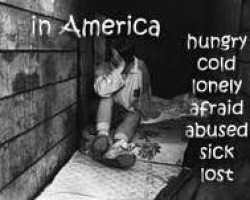
NYT-
More than 50,000 New Yorkers slept in city homeless shelters and on the streets last night. About 21,000 were children. These numbers are huge and appalling, higher than they were in 2002, when Mayor Michael Bloomberg took office, higher than in the dismal days of the fiscal crisis, the Reagan ’80s and the surly administration of Rudolph Giuliani.
New Yorkers who have no permanent place to live form a small city unto themselves — an abandoned one. The shelter population has risen 61 percent while Mr. Bloomberg has been mayor, propelled by a 73 percent increase in homeless families, according to the Coalition for the Homeless, whose relentless advocacy has been provoking mayoral fury since the 1980s. These surging numbers — of families with children, especially — undercut claims that New York is steadily becoming a better place to live, and that its government has gotten better at helping its most vulnerable citizens meet their most basic needs.
© 2010-19 FORECLOSURE FRAUD | by DinSFLA. All rights reserved.



Most of this is due to the banks crimes.
Jump to: navigation, search
Wall Street and the Financial Crisis: Anatomy of a Financial Collapse is a report on the financial crisis of 2007–2008 issued on April 13, 2011 by the United States Senate Permanent Subcommittee on Investigations. The 639 page report was issued under the chairmanship of Senators Carl Levin and Tom Coburn, and is colloquially known as the Levin-Coburn Report. After conducting “over 150 interviews and depositions, consulting with dozens of government, academic, and private sector experts” found that “the crisis was not a natural disaster, but the result of high risk, complex financial products, undisclosed conflicts of interest; and the failure of regulators, the credit rating agencies, and the market itself to rein in the excesses of Wall Street.” [1] In an interview, Senator Levin noted that “The overwhelming evidence is that those institutions deceived their clients and deceived the public, and they were aided and abetted by deferential regulators and credit ratings agencies who had conflicts of interest.”[2] By the end of their two-year investigation, the staff amassed 56 million pages of memos, documents, prospectuses and e-mails.[3] The report, which contains 2,800 footnotes and references thousands of internal documents [4] focused on four major areas of concern regarding the failure of the financial system: high risk mortgage lending, failure of regulators to stop such practices, inflated credit ratings, and abuses of the system by investment banks. The Report also issued several recommendations for future action regarding each of these categories.
The Financial Crisis Inquiry Commission released its report on the financial crisis in January 2011.
Contents
1 Report findings
1.1 High Risk Lending: Case Study of Washington Mutual Bank
1.2 Regulatory Failures: Case Study of the Office of Thrift Supervision
1.3 Inflated Credit Ratings: Case Study of Moody’s and Standard & Poor’s
1.4 Investment Bank Abuses: Case Study of Goldman Sachs and Deutsche Bank
2 Report recommendations
2.1 Recommendations on high risk lending
2.2 Recommendations on regulatory failures
2.3 Recommendations on inflated credit ratings
2.4 Recommendations on investment bank abuses
3 Impact and reactions
3.1 Media reaction
3.2 Wall Street reaction
3.3 Legislative reaction
4 External links
5 References
Report findings
The Report found that the four causative aspects of the crisis were all interconnected in facilitating the risky practices that ultimately led to the collapse of the global financial system. Lenders sold and securitized high risk and complex home loans while practicing subpar underwriting, preying on unqualified buyers to maximize profits. The credit rating agencies granted these securities safe investment ratings, which facilitated their sale to investors around the globe. Federal securities regulators failed to execute their duty to ensure safe and sound lending and risk management by lenders and investment banks. Investment banks engineered and promoted complex and poor quality financial products composed of these high risk home loans. They allowed investors to use credit default swaps to bet on the failure of these financial products, and in cases disregarded conflicts of interest by themselves betting against products they marketed and sold to their own clients. The collusion of these four institutions led to the rise of a massive bubble of securities based on high risk home loans. When the unqualified buyers finally defaulted on their mortgages, the entire global financial system incurred massive losses.